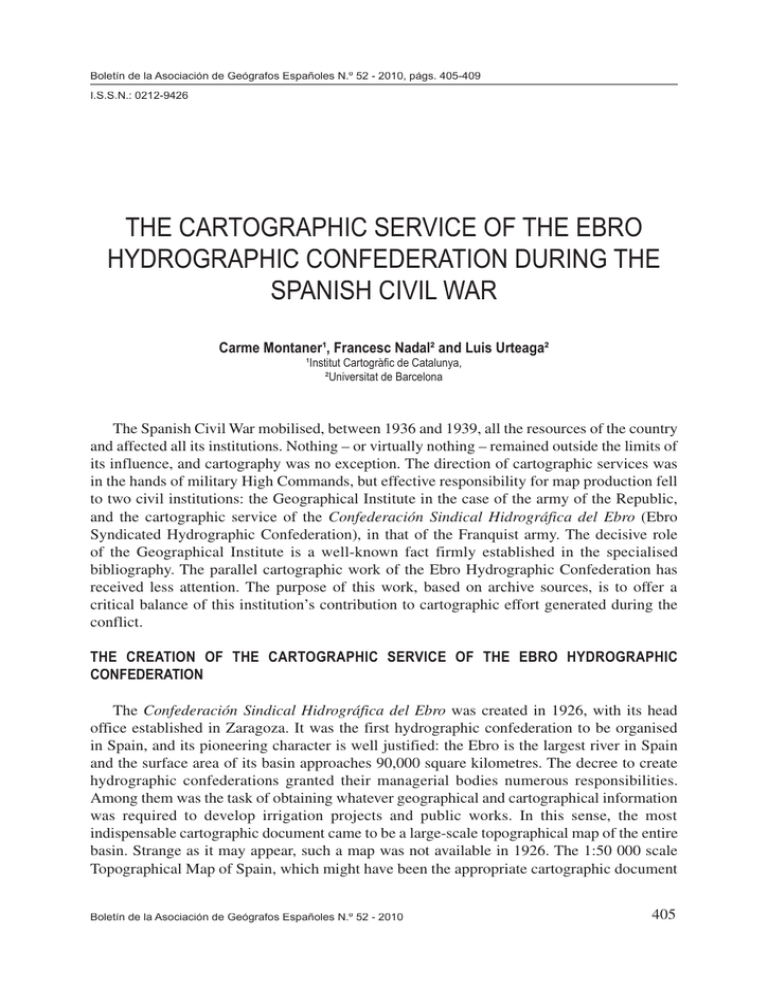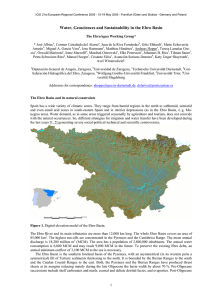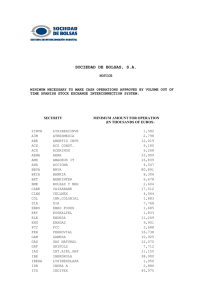the cartographic service of the ebro hydrographic confederation
Anuncio

Boletín de la Asociación de Geógrafos Españoles N.º 52 - 2010, págs. 405-409 I.S.S.N.: 0212-9426 THE CARTOGRAPHIC SERVICE OF THE EBRO HYDROGRAPHIC CONFEDERATION DURING THE SPANISH CIVIL WAR Carme Montaner¹, Francesc Nadal² and Luis Urteaga² ¹Institut Cartogràfic de Catalunya, ²Universitat de Barcelona The Spanish Civil War mobilised, between 1936 and 1939, all the resources of the country and affected all its institutions. Nothing – or virtually nothing – remained outside the limits of its influence, and cartography was no exception. The direction of cartographic services was in the hands of military High Commands, but effective responsibility for map production fell to two civil institutions: the Geographical Institute in the case of the army of the Republic, and the cartographic service of the Confederación Sindical Hidrográfica del Ebro (Ebro Syndicated Hydrographic Confederation), in that of the Franquist army. The decisive role of the Geographical Institute is a well-known fact firmly established in the specialised bibliography. The parallel cartographic work of the Ebro Hydrographic Confederation has received less attention. The purpose of this work, based on archive sources, is to offer a critical balance of this institution’s contribution to cartographic effort generated during the conflict. THE CREATION OF THE CARTOGRAPHIC SERVICE OF THE EBRO HYDROGRAPHIC CONFEDERATION The Confederación Sindical Hidrográfica del Ebro was created in 1926, with its head office established in Zaragoza. It was the first hydrographic confederation to be organised in Spain, and its pioneering character is well justified: the Ebro is the largest river in Spain and the surface area of its basin approaches 90,000 square kilometres. The decree to create hydrographic confederations granted their managerial bodies numerous responsibilities. Among them was the task of obtaining whatever geographical and cartographical information was required to develop irrigation projects and public works. In this sense, the most indispensable cartographic document came to be a large-scale topographical map of the entire basin. Strange as it may appear, such a map was not available in 1926. The 1:50 000 scale Topographical Map of Spain, which might have been the appropriate cartographic document Boletín de la Asociación de Geógrafos Españoles N.º 52 - 2010 405 Carme Montaner, Francesc Nadal and Luis Urteaga as a base for planning work, was long overdue. In 1926, only 15 of the 214 sheets covering the Ebro Basin had been published. Given the surface area still to be drawn up – over 70,000 square kilometres – and the urgency with which the map was required, support had to be requested from the two main cartographic agencies of the State: the Instituto Geográfico y Catastral (Geographical and Cadastral Institute) and the Depósito de la Guerra (Military Archive). In 1927, the Instituto Geográfico y Catastral agreed to carry out the emergency surveying of 2,133,000 hectares and to hand over to the Confederation the survey data at a scale of 1:25 000, with contour lines at 10 metre intervals. At the same time, the Depósito de Guerra agreed to complete within 12 months a total of fourteen map sheets covering the Pyrenees area. There was still one urgent need to be attended to. In partially irrigable zones, for various reasons, a detailed parcel map of rustic land was required, but was lacking in the greater part of the basin. To obtain one, in 1927, an innovative solution was opted for: the contracting of an aerial photogrammetric survey to be carried out by the Compañía Española de Trabajos Fotogramétricos Aéreos - CETFA (Spanish Company for Aerial Photogrammetric Work). In addition to these measures and agreements, those in charge of the Confederation decided it ought to have a cartographic service of its own. The service was started with a modest budget and limited personnel: one geographical engineer in charge of the service, an assistant engineer, four topographers, a draughtsman and an expert in photography. Direction was entrusted to the geographical engineer Carlos Valentí Dordá. However, between 1928 and 1936, the cartographic service of the Ebro Hydrographic Confederation became an important cartographic centre. At the moment of the military coup, the Confederation boasted a workshop for photography and reprojection, a draughting room, a section for making copies of plans on Ozalid paper equipped with two machines and a complete cartographic archive. The archive contained, at that time, a collection of 169 sheets of the 1:50 000 scale Topographical Map of Spain, which covered practically all the Ebro Basin; a collection of the manuscript data of this map on vegetable paper at 1:25 000 scale, with contour lines at 10 metre intervals, as well as a collection of 22,000 aerial photographs taken between the years 1928 and 1930, with the corresponding photoplans at 1:10 000 scale, which covered an area of 1,343,000 hectares of the central zone of the Ebro Valley. Three aspects are worthy of special note in this impressive cartographic documentation: its coverage, its up-to-dateness, and its exclusiveness. In fact, this collection covered practically the entire Ebro Valley, precisely the zone in which the most important battles of the Civil War would be fought. Furthermore, the photoplans produced by the Compañía Española de Trabajos Fotogramétricos Aéreos (Spanish Company for Aerial Photogrammetric Work) were only to be found in Zaragoza, in the archives of this cartographic service. THE MILITARIZATION OF THE CARTOGRAPHIC SERVICE The triumph of the military uprising in Zaragoza on July 19 1936 was a real stroke of luck for the insurgent military, among other reasons, because of the documentary wealth harboured in the basements of the Ebro Hydrographic Confederation. The inability of the rebel forces to gain control of Madrid left the country’s main cartographic agencies, with their headquarters 406 Boletín de la Asociación de Geógrafos Españoles N.º 52 - 2010 The Cartographic Service of the Ebro Hydrographic Confederation during the spanish civil war in the capital, in the hands of the Republican Army. As a result, the military behind the coup were initially deprived of the cartographic resources essential to satisfy their war needs. From this angle, the crucial importance of the Ebro Confederation’s cartographic resources in rebel hands can be understood. According to the account of the geographical engineer Carlos Valentí Dordá, who continued at the head of the service throughout the conflict, collaboration with the Franquist military forces began at the very outset of the insurrection. The Confederation’s installations and resources were assigned to the Topographical Section of the 5th Organic Division, under the leadership of the Lieutenant Colonel of High Command Darío Gazapo. During the course of the war, the Confederation’s cartographic service was made up of 20 people, with Carlos Valentí Dordá remaining ratified as its chief. USE OF AERIAL PHOTOGRAPHS IN THE CARTOGRAPHIC SERVICE OF THE EBRO HYDROGRAPHIC CONFEDERATION A key factor in the Confederation’s cartographic service, in July 1936, was having at its disposal a photographic laboratory specialised in cartographic work, with the appropriate personnel to run it. Photographic techniques had given cartography considerable impulse since the First World War. The assignment given by the Confederation to the company CETFA in 1927 was the production of photoplans at 1:10 000 scale of more than one million hectares in the irrigable areas within the basin. At the outbreak of the Civil War, more than 600 photoplans had been made, occupying totally or partially 49 sheets of the 1:50 000 scale Topographical Map of Spain. The cartographic service of the Ebro Hydrographic Confederation took an active part in the entire elaboration process of these works, not only carrying out verification operations of the sheets which were being delivered, but also establishing the technical characteristics which CETFA was to follow for their production. The training acquired by personnel during the progress of this work was to be of vital importance for the later running of the cartographic service during the war. The over 4,000 photographic copies made of the photoplans conserved in the cartographic service testify to the importance of its photographic workshop. The photoplans were also used as base cartography for the creation of 1:25 000 scale plans of the Aragon front, and of the zone where, in 1938, the republican offensive on the Ebro was fought. In order to complete sheets, the service constructed 30 new photoplans from photographic mosaics provided by the Franquist army itself, or by its allies, onto which contour lines were drawn from the maps in the service’s own archive. This process, somewhat imprecise and very slow, and for which the entire staff of the service needed to be employed, was nevertheless necessary to obtain certain essential sheets at 1:50 000 scale corresponding to zones in the Castellón and Valencia provinces where information was totally lacking. Throughout the entire war, photointerpretation work was also carried out, as well as all the photographic workshop’s own production, consisting of film developing, photographic copies, and other activities. The total of photographic copies of different sizes made in its laboratory was 11,403. Boletín de la Asociación de Geógrafos Españoles N.º 52 - 2010 407 Carme Montaner, Francesc Nadal and Luis Urteaga CARTOGRAPHIC ACTIVITY DURING THE CIVIL WAR The basic cartographic activity of the cartographic service of the Ebro Hydrographic Confederation during the Civil War consisted of supplying all types of maps to the various units of the insurgent army. To this end, it carried out major work in the publication of largescale cartography from documentation contained in its own archive, right at the outset of the war. The aim was far exceeded. During the course of the war, it provided different units of this army with 857,195 copies of the main maps used in the conflict, a figure representing 59.3% of all copies supplied to the said units by the different cartographic institutions ascribed to the Franquist army. In order to print this vast amount of maps, the cartographic service undertook, from the outbreak of the conflagration, three different types of task: 1) it transformed a body of cartographic documentation of civil character into another of military type; 2) it organised an archive of maps of the main war fronts, in constant growth; and, 3) it improved and increased the available means of graphic reproduction. Firstly, it set about converting the cartographic documentation available in mid-July 1936, which was basically civil in character, into one of military type. To this end, the military grid on a Lambert projection was drawn on most of the maps printed during the war. Another activity conducted was the organisation of an efficient archive of original maps, photoliths, and copies of lithographic maps and on Ozalid paper. However, the most important enterprise undertaken by the cartographic service was the massive reproduction of maps. From September 1936 onwards, copies on Ozalid paper were made of the existing sheets at 1:25 000 scale. Later, at the start of Februray 1937, printing of copies began using a type of paper called «Aluna», which helped to reduce staff and to speed up the map reproduction process. In July 1937, the technical resources of the company Talleres Offset Nerecan SA of San Sebastián, and those of the Heraclio Fournier factory in Vitoria, began to be used in an integrated fashion in the process of cartographic printing. The main printing effort went into the series «Mapa Nacional» at a scale of 1:50 000, of which the Franquist army was supplied with 665,129 copies corresponding to 674 different sheets. Many of the sheets corresponding to territories located outside the Ebro water basin had to be compiled from very heterogeneous cartographic documentation, which was very deficient for some zones. Substantial print runs were also made of the Mapa del Mando (Command Map) at 1:100 000 and of the Plano Director at 1:25 000. Itinerary cartography received special attention, with copies of the 1:200 000 scale Mapa Itinerario Militar de España (Military Route Map of Spain) being published, and a special edition being compiled of the 1: 400 000 scale Mapa Michelin de Carreteras de España (Michelin Road Map of Spain). A wide range of maps was also published with smaller print runs. CONCLUSIONS The Franquist army’s lack of maps had been pointed out previously, but the decisive role played by the cartographic service of the Ebro Hydrographic Confederation in palliating this deficiency had not been analysed in detail. The insurgent army soon realised that this Confederation had a cartographic service in Zaragoza which combined three key factors: 408 Boletín de la Asociación de Geógrafos Españoles N.º 52 - 2010 The Cartographic Service of the Ebro Hydrographic Confederation during the spanish civil war personnel specialised in cartographic work and in the latest photographic techniques applied to maps, an archive of plans and photographs of recent date, totally or partially covering the Ebro Basin, and, lastly, well-equipped installations. The first step taken was the militarization of personnel and installations, which came under control of Lieutenant Colonel of High Command Darío Gazapo, chief of the Topographical Section of the 5th Organic Division with its headquarters in the Aragonese capital. Throughout the whole war, this cartographic service was engaged in gathering geographical information and preparing it for publication and later distribution among the commands of the Franquist troops. The reproduction processes were improved and, in a short time, simple sheet-by-sheet copies were replaced by complex processes of published editions. Printing activity was not restricted merely to areas within the Ebro Basin, but embraced most of Spain. The importance of the cartographic work carried out by this cartographic service in Zaragoza is reflected by the fact that almost 60% of the cartography used by the Franquist army originated from it. In fact, this cartographic service, despite its civil character, acted as the official cartographic centre of Franco’s army. Boletín de la Asociación de Geógrafos Españoles N.º 52 - 2010 409



